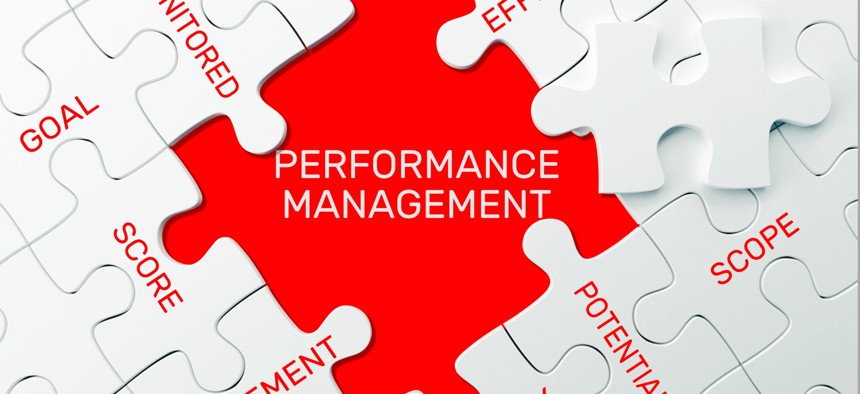
Canan turan / Getty Images
No better way to manage performance
COMMENTARY | OPM's new performance management guidance looks to refine how federal agencies tackle employee performance, but to reach its mark, the federal government’s HR agency should explore how to empower employee problem-solving.
The June 17 memo from the Office of Personnel Management’s acting Director Charles Ezell, “Performance Management for Federal Employees”, reflects an important development for managing employee performance. The new approach is the use of S.M.A.R.T – Specific, Measurable, Achievable, Relevant and Time-bound – goals to plan and monitor employee performance. The goal is building “a high-performance Federal workplace culture.”
Management textbooks include exhibits showing interlinked level-by-level individual goals aligned with agency goals. Everyone can understand how their work efforts are expected to contribute to their department’s and their employer’s success. It’s a common practice in successful companies.
The new policy also provides for rewarding high performers with “meaningful bonuses and awards.” It’s unlikely the promise of small, year-end awards will drive employee motivation throughout the year but there is definitely a sense of accomplishment followed by recognition when they receive the awards. That is if the process is not tainted by favoritism and distrust.
The memo was silent on a core issue – employees need to be empowered to tackle problems. If employees are to be accountable for achieving goals, they need to have the discretion to act as needed to tackle problems. In the NPR “reinventing government” years one of operating principles was: “Empowering employees to get results.” It contributed to the largest performance gains in decades. In moving to goal-based management, agencies should start by assessing the culture to learn if managers are ready.
As a caution, where there is little trust and workers are expected to comply with established principles, the transition will not be quick or easy.
Agencies will also need to assess how this will change manager/employee relationships. Where the use of employee goals is new, it will redefine their relationship and both require new skills and behaviors. That makes it important to approach this as culture change and provide adequate training.
Goal-based management is proven
This is essentially the same strategy the state of Tennessee initiated in 2011 as the basis for civil service reform. It was a solid success. The state went further and adopted a pay-for-performance salary increase policy. Agencies realized notable performance gains and today state agencies are recognized as “best places to work.” Writers have posted articles wondering if “…Other states can tap Tennessee’s secret sauce for government efficiency?”
Several years ago, Steve Goodrich brought Tennessee’s human resource commissioner, Rebecca Hunter, to Washington and had her meet with several groups to discuss what they accomplished. Unfortunately, the COVID crisis intervened, and her story was quickly forgotten. (The ebook I co-authored with Tennessee’s Chief Learning Officer, Trish Holliday, “Preparing Managers for Tomorrow's Government”, may be useful. It’s available here.)
If the transition is managed effectively, “fully successful” ratings should be limited to managers and employees who achieve their goals. Generally, goals represent improved performance over the prior year. If all employees perform at that level, it should be seen as a good year.
For reasons that again are not clear, goal-based management has a long history in government – the Government Performance and Results Act introduced the practice two decades ago – but the focus was and has been on agency goals. In contrast to business, agency leaders along with senior executives were not accountable for agency performance. In business, when a company’s results do not satisfy the stockholders, they are quickly replaced.
Again, in business as well as health care, year-end incentive awards are based by formula on achieving a combination of organization and individual goals. The executives as a “team” are accountable and rewarded for their company’s success.
Defining goals that are mutually accepted
In a traditional management environment, employees were told what to do and supervised closely to see they satisfy expectations. Performance expectations or standards were dictated.
Goal-based management requires a very different philosophy. Engaged employees are known to perform at higher levels, and managers are the keys to creating a supportive environment that builds employee commitment. Managers and employees need to work closely in defining goals and reacting to developments that affect goal achievement. That requires a good working relationship.
It also requires a relationship where employees are not afraid to fail, knowing they can look for advice or help to tackle problems.
Employees always know what they can expect to accomplish, the barriers that are likely to affect their performance and what for them is unacceptable performance. There is research showing in setting personal goals, many set high expectations. Here they want to make a contribution, but they also want to be treated fairly. That means goal setting works best when employees are involved in the goal setting process.
Performance goals define accountability
The word “accountability” seems to be omnipresent today. Interestingly, it’s rare to see the word “accountable” in discussions of business results. It’s understood, of course. It’s apparently never been studied – a search failed to find studies – but in agreeing to performance goals, employees in business understand they are expected to achieve the goals.
In their year-end evaluations, managers evaluate employee performance relative to goals. But more importantly, throughout the year, the goals and metrics provide a basis for managers and employees to discuss what’s unfolding. That information enables managers to provide ongoing coaching and advice. As circumstances change, goals often need to be revised. If that’s accountability, it works.
That’s true for team goals as well. Working to achieve team goals builds camaraderie.
Performance goals do not fit every occupation
Managing with SMART goals does not reflect the nature of work in the so-called knowledge occupations. A “knowledge worker is a professional who generates value for the organization with their expertise, critical thinking and in some cases interpersonal skills.” “They think for a living.” Many have graduate degrees although there are many exceptions.
They include the specialists in technology fields, engineers, architects, lawyers, physicians and scientists, along with occupations where individual work assignments and year end goals cannot be planned. An example would be nurses where daily activities cannot be anticipated. Often the best are assigned to deal with the toughest problems. It’s their knowledge and skills that determine their value. Seniority or years of experience are not relevant although that may be difficult to accept.
The alternative for knowledge jobs is competency-based pay where pay increases are based on an assessment of an employee’s progress in developing their knowledge and skills.
The first demonstration project, China Lake in 1980, was based on what was then an innovative program model – salary banding – that is now proven and accepted as the basis for managing knowledge worker salaries. The success of the “demos” confirms the acceptance of the program model.
Managers play a vital role
Studies going back more than two decades show managers play a vital role in supporting good performance. Government, unfortunately, has a history of promoting senior workers or those with good technical skills to manager positions. That may have been OK when workers were only expected to do what they were told. Now, however, the experts recognize that workers are capable of performing at much higher levels when they are empowered and coached with feedback to improve performance.
That is a very different role for managers. In fact, it can be argued that when employee performance is unacceptable, its very likely poor supervision played a role.
It’s particularly important for effective management to start at the highest levels. That was an advantage in Tennessee where the governor and several agency heads had been executives in large companies. Too often appointees are “experts” but do not have experience managing large employee groups. A fallback is the appointment of a chief operating officer supported by executives with program management experience.
The key point is that managers are too important. They need adequate training. In Tennessee, the rollout took place over three years; the first two were “practice”. It was not until the third year that managers and their performance ratings were linked to salary increases.
Today several companies market software to record goals and metrics to help managers and employees track progress over the year. Goal management is more powerful when everyone can follow progress.
It’s not an HR problem; it’s a leadership problem. Agencies have very different management problems, making one-size-fits-all edicts on how to proceed suspect. Culture change takes time. There are likely to be setbacks and resistance. But after decades of announced plans to raise performance levels, focusing on the management of employee performance has the best chance of succeeding.
Looking back over the history of the civil service system, this is the first broad scale attempt to transform the work culture of federal agencies. The demos and agencies with "alternative personnel systems" successfully transitioned away from the traditional civil service rules and regulations. But this will be the largest attempt at organizational change ever undertaken.







